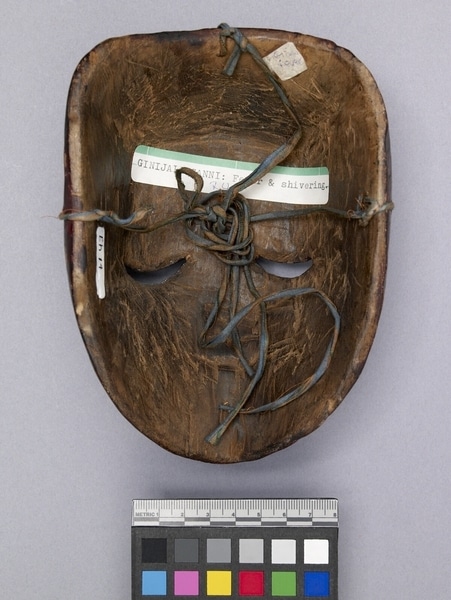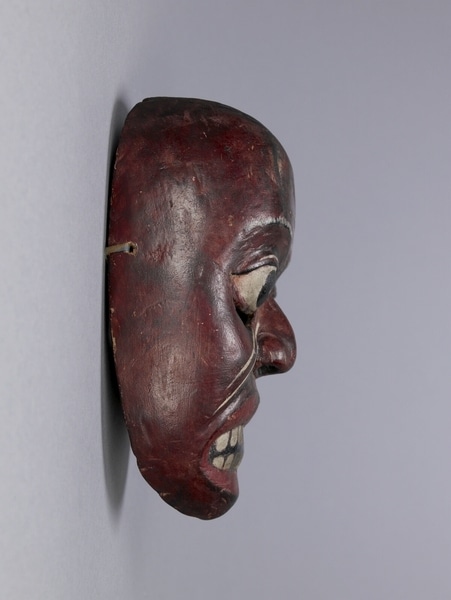Mask Item Number: Eh14 from the MOA: University of British Columbia




Description
Mask depicting Ginijala Sanniya (who represents fever and shivering) which has a dark red face with bulging eyes with crescent-shaped slits under each, eyebrows in white on black, a small nose with flared nostrils, and a grimacing mouth with red lips and white teeth bordered in black. There are three horizontal white lines at the centre of the forehead, and two diagonal white lines on each cheek. A thin strip of green and brown fabric is strung through three holes at the edges of the mask: one at the top of the head, and two either side of the mask. Label on reverse of mask reads, "GINIJALA SANNI: Fever & shivering, " in typewritten characters, and "24" handwritten in blue ink.
History Of Use
Worn during curing ritual of the Sanni Yakuma ceremony, part of the Tovil series of dramas performed by Sinhalese ritual specialists and dancers. The Sanni Yakuma is intended to combat diseases and afflictions caused by the Sanni group of demons. These consist of 18 or more apparitions of the chief demon, Maha-kola-sanni. The officiating healer honours Buddha, then appeases the demons with offerings, dancing, and chanting. This mask is probably Ginijala Sanni, whose symptoms include shivering and high fever.
Iconographic Meaning
Distinctive elements associated with fever and shivering include a dark red colour, and painted lines on the forehead representing furrows. There are also painted lines on the cheeks in the form of flames indicating fever.
Cultural Context
exorcism
Item History
- Made in Sri Lanka before 1978
- Collected during 1978
- Owned by Jason Schoonover before February 10, 1981
- Received from Museum of Anthropology Shop Volunteers (Funding source) and Jason Schoonover (Seller) on February 10, 1981
What
- Name
- Mask
- Identification Number
- Eh14
- Type of Item
- mask
- Material
- nux vomica wood ?, cotton fibre ?, paint and dye
- Manufacturing Technique
- carved and painted
- Overall
- height 17.0 cm, width 12.2 cm, depth 7.5 cm
Who
- Culture
- Sinhalese
- Previous Owner
- Jason Schoonover
- Received from
- Museum of Anthropology Shop Volunteers (Funding source) and Jason Schoonover (Seller)
Where
- Holding Institution
- MOA: University of British Columbia
- Made in
- Sri Lanka
When
- Creation Date
- before 1978
- Collection Date
- during 1978
- Ownership Date
- before February 10, 1981
- Acquisition Date
- on February 10, 1981
Other
- Condition
- fair
- Accession Number
- 0704/0013